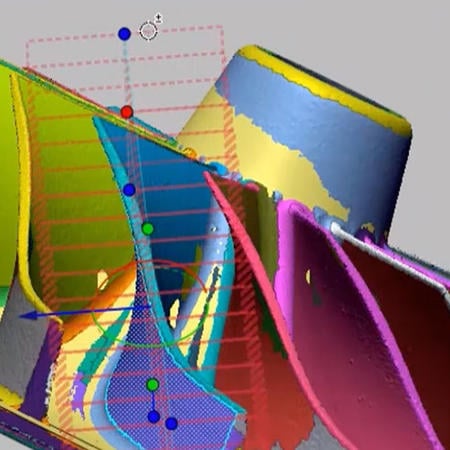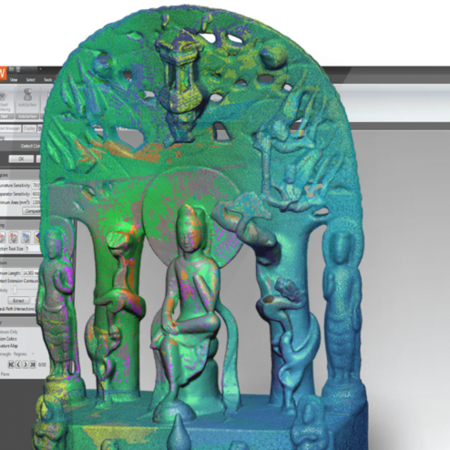"3D Systems offers some great software code with great number crunching algorithms, and Geomagic is the best at working with very, very, huge point clouds,"
Kim Gruber is one of those fortunate people who have managed to build a passion for cars into a successful career in Detroit’s automotive styling and engineering world. His weekdays are spent on 3D scanning contracts and 5-axis milling work with major automotive companies. But his weekends are filled with unique antique cars and trucks: scanning and Class-A surfacing for archive, parts restoration, CFD analysis or maybe just for fun.
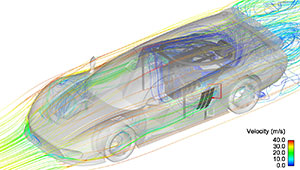
After more than 20 years in the automotive industry since graduating from Louisiana State University, Kim, with his company Millit5 based in Milford, Michigan, simply loves cars and loves showing gearheads the advanced technology he uses for classic car restorations. Millit5’s services include 3-D scanning, inspection, 3D printing, ICEM automotive Class-A surfacing, CFD flow analysis, 5-axis milling, and training. The Millit5 Digital Garage approach uses only the best tools and quickest software. Kim’s toolbox includes Geomagic® scanning and reverse engineering software from 3D Systems, ICEM Surf and ICEM DDN, Creaform MAXscan, and scanning and photogrammetry from Creaform on every automotive project.
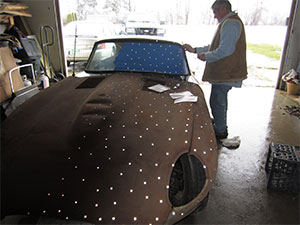
Reverse engineering, 3D scanning, 3D printing and milling are technologies that make perfect car restorations possible. Every Sunday during the summer, Millit5's Digital Garage also puts up a booth at local car shows to help people understand more about the technology. Each winner at these car shows gets 3D scan and 3D print of his winning car, compliments of Kim and Millit5.
One day in 2013, while visiting friends, Kim was discussing his recent Saleen S7 super car Digital Garage project. After scanning the super car inside and out, he used the scan data to generate a Class-A surface and 3D printed it as a 20-inch super car model. Next, he generated CFD flow analysis for both the interior and exterior of the car, and then created a 5-axis, 40% scale model for acoustic analysis wind tunnel testing.
On hearing the Saleen S7 story, Frank Tytar mentioned that he had a 1963 Jaguar XKE in his garage that he got from his father-in-law, Doug Hackenbruch, who was the head metallurgist at Tank Plant in Detroit. Beneath a layer of rust on the body there was beauty along with the classic style, ride and performance that makes the XKE the favorite of Jay Leno as well as others.
The car was about to undergo a total renovation, and Frank wanted to digitally test and verify the proposed aerodynamics changes before he spent money on the restoration.
Within a week of seeing the Jaguar in Frank’s garage, Kim began scanning it in the frigid air of a cold December morning. Car scan preparation started with the application of six-millimeter magnetic targets on the vehicle, which were used for automatic alignment of the scans. The crew taped off the windows with masking tape and then attached sticky targets. The team used a Creaform MAXscan handheld scanner to take a couple of photogrammetry shots, and then began the complete car scan. The 3D data set from scanning a car is very large, incorporating one millimeter of coverage across vehicles, so Millit5 used Geomagic tools to process data as accurately and easily as possible. Recently, Millit5 also started testing Geomagic® Design X capabilities to integrate the hybrid world of scan and solids with great success.
"3D Systems offers some great software code with great number crunching algorithms, and Geomagic is the best at working with very, very, huge point clouds," said Kim.
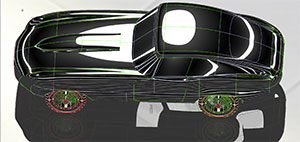
After the Geomagic software processed all scan data, it was imported into ICEM to start the Class-A surfacing. Class-A surfaces describe any styling surface with highlights that can be seen or touched on the exterior of a car. If you look at new car in the bright lights of a dealership showroom, you will see perfect surfaces and highlights running down the car’s side: these are the Class A surfaces. ICEM is a superb surface-tweaking tool, which allows designers to see how highlights change in real time as surface control points are carefully manipulated in the digital world.
Although you can identify dents and dings in the digital design, sometimes there’s nothing like a 5-axis milled model to really identify the areas that are not perfect. Once complete, the surfaces are matched to G2 and G3 surface quality (a requirement for today’s car designs). For the Jaguar XKE project, Kim used his expertise to produce Class-A surfaces with proper design intent and a tolerance of .5 milimeters deviation scan-to-surface for downstream CFD flow analysis.
Kim produced a 16-inch, 3D printed SLA prototype of the Jaguar after the surfaces were finished. For larger, full-size models, clay 5-axis CNC is the best tool for wind tunnel testing. When it comes to this type of CNC and milling, Kim is an expert, having spent 12 years at Ford Motor Company Product Development Center, teaching and training in milling from ICEM Class-A surfaces. He’s also 3D scanned and 5-axis milled hundreds of proprietary trucks and car models throughout his career for the big three in Detroit.
Although Kim describes himself as a "digital automotive studio engineer," he also enjoys putting his skills to use in non-automotive projects. In one such project, Kim scanned an original Purple Heart medal owned by Veteran Captain Eugene Donovan (doctor) from Farmington Hills , Michigan, who was wounded in WWII. After he 3D scanned the medal, he enlarged it, creating a 16-inch tall Purple Heart that was milled in black walnut wood for a veteran recognition award.
"Once you have the 3D scan data, it is ideal to be scaled up or down to make perfectly scaled models and replicas," said Kim. "You can do anything with the data once you have it, including scaling, morphing or even milling it!"
"Digital Cars are my passion,” said Kim. "But I always enjoy using amazing technologies to educate gear heads and non-car folks alike."
